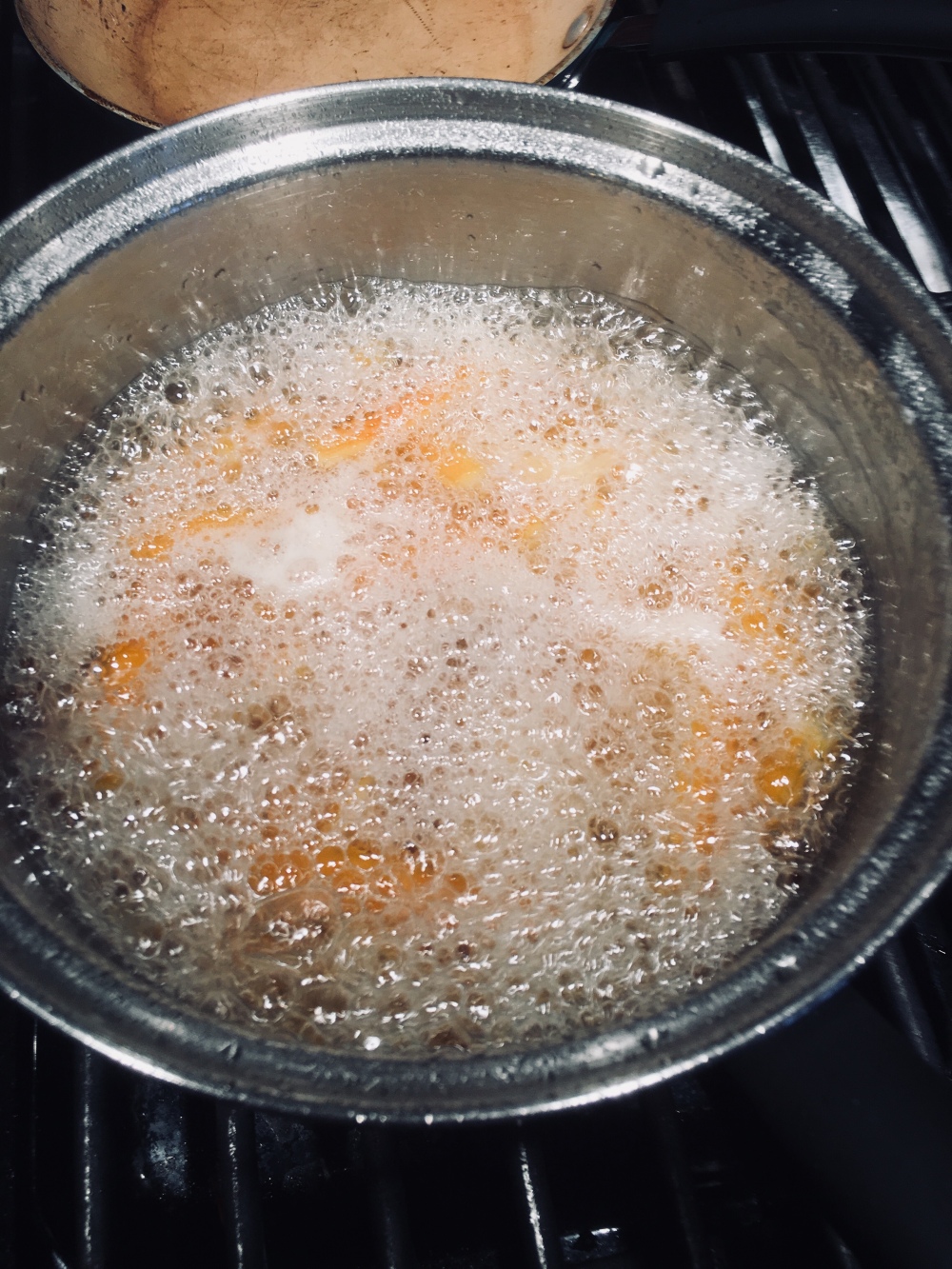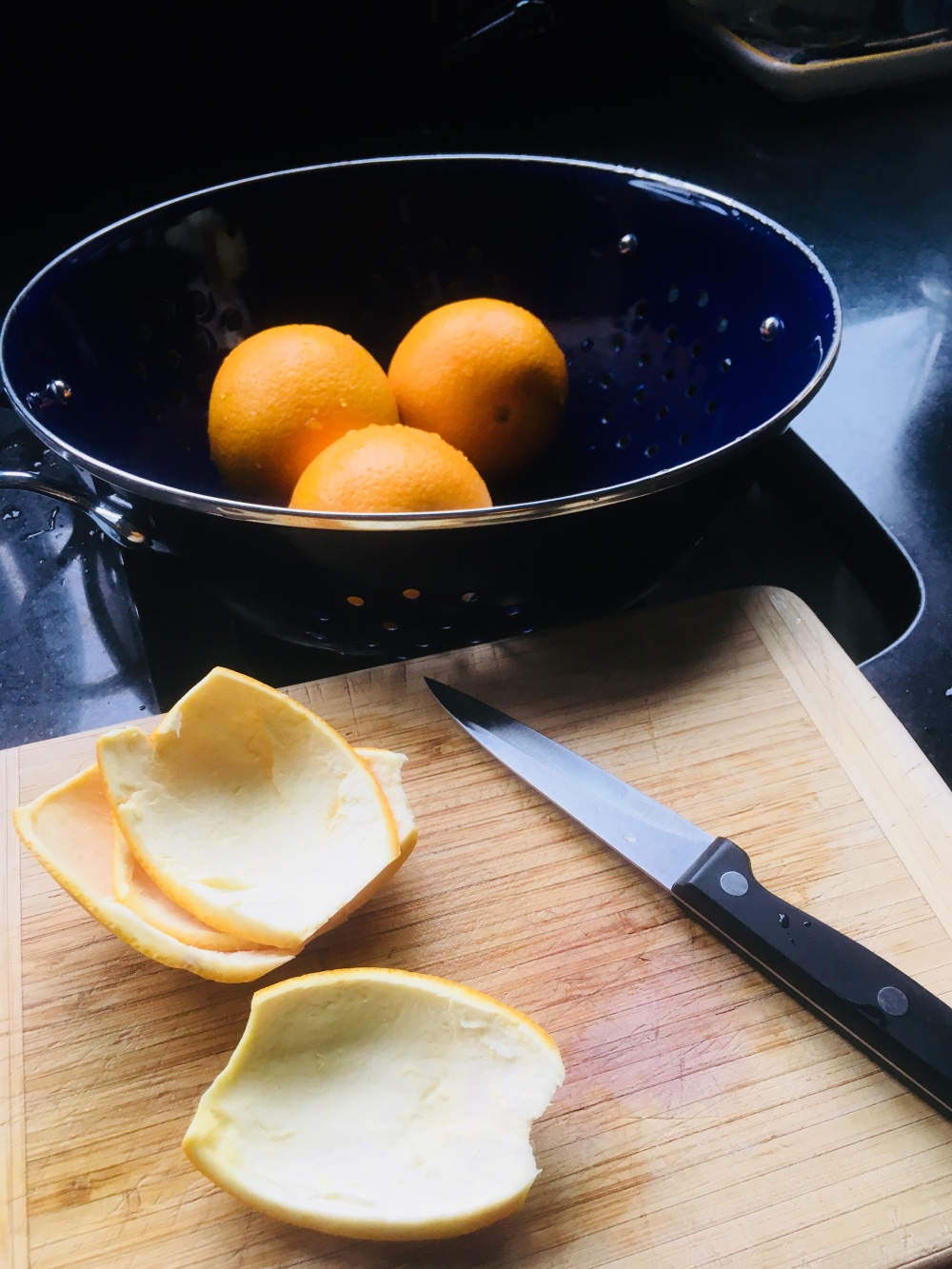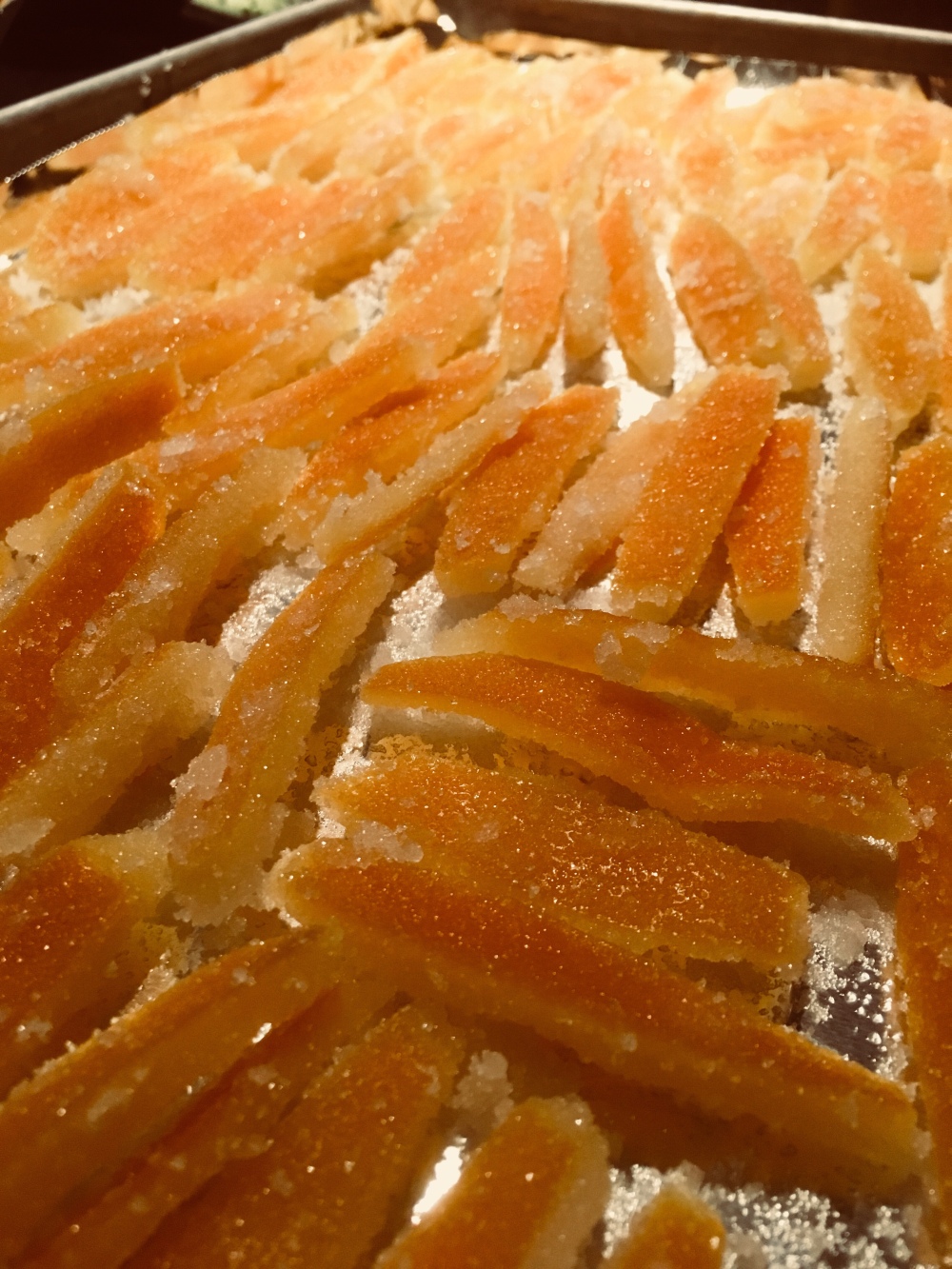One of the things I love most about the time between Thanksgiving and Christmas is all the baking and candy-making. There’s nothing quite like humming Christmas carols while whipping up a batch of gingersnaps or crafting a pie.

Lately, I’ve been fascinated by candy-making. I remember the one time my grandmother and I tried making divinity, America’s answer to the honeyed, nutty goodness of French nougat (which I much prefer, incidentally, to divinity, but that’s another story). Despite our best attempt with the candy thermometer, the candy failed miserably. Since then, I’ve had an aversion to all things involving melting sugar.
But last year, on my twenty-first birthday, a lovely couple from the church invited my roommate and me over for lunch. The wife set out candied orange slices with the after-meal coffee, and I fell in love with what I consider the adult version of the flavoured orange-shaped chocolates of my youth.

Over the summer, I attempted a recipe for the candied slices, and while it worked, it was far from the success I imagined. The slices took forever to dry, and when I gave them a little help in a warm oven, they turned to leather. A little chocolate took care of that of course, and we still devoured them. But I was still searching for the perfect chocolate-covered candied orange.
We spent Christmas in Nebraska, where I experimented with mulled wine (more specifically, the vin chaud or glühwein served in Christmas markets). Since I left Switzerland in early December, I only enjoyed this seasonal treat at one Christmas market. My family had never tried this European treat, so I decided to give it a go.

It’s worth it, let me tell you. A bottle of red wine, two cloves, a star anise, a cinnamon stick, some cardamom, and an entire orange sliced into half-moons fill the house with fragrance as they simmer gently on the stove. Heat to just before boiling, then let sit, covered, for ten minutes (or longer, if you prefer). Reheat, ladle into mugs, and sip. I like to nibble on the wine-infused orange slices, too. For both vin chaud and candied oranges, I buy organic oranges and to wash them well. I’m not usually one to insist too much on something being organic, but when I’m going to be eating orange peel, I want it to be as natural as possible.
Anyway, after making the first batch of vin chaud, I still had eight organic oranges left. I’d seen a recipe for candied orange peel, so I gave it a try, thinking it would be easier and more successful to candy just the peel than whole slices.

And it was. I peeled the oranges, sliced the peel, boiled three times in clean, fresh water, and then simmered in sugar syrup until they turned translucent. They spent the night on the counter drying, then I rolled them in sugar. They’re good as-is, or dipped in chocolate, and best enjoyed with a good mug of spiced tea or with coffee. I can imagine they’d make good accompaniments to a broad range of desserts, too, and they’d be a sweet little gift in a plastic bag tied with ribbon. If they last that long, that is!

Now, back in Switzerland, recovering from jet lag, I’m realising that because I’ve graduated, I need to find something to do. Discipline is the key word here, as I’ve got books I want to read, a few crochet and embroidery projects hanging around, plenty of things I’d like to write, not to mention an apartment to decorate, friends to visit, recipes to make, and essential oils to play with. I want to keep myself disciplined in managing all of this in a way that means I won’t be sitting alone in an apartment doing something as prosaic and useless as watching hours of Netflix or using social media. But, I do need some kind of cadre, a framework to help me structure my days and weeks, which means I need to exercise my sorely out-of-shape scheduling skills.
Taking time off is not easy for me—I’d much rather jump right into a job or another degree, just to give myself something to do. But I know it’s not the right time for those things yet; I really do need time to settle in and make myself at home. In light of that, I do have a few plans, such as signing up for German classes and making a point of regularly blogging.
Planning to keep myself occupied naturally includes lots of time in the kitchen. My obsession with citrus is continuing, not in the least because they’re in season, so they’re less expensive than before and look fantastic on the supermarket shelves. The other day, I bought a bag of limes thinking they’d be great for some sirop, which is essentially a simple syrup that’s added to drinking water. At first, the water in this apartment tasted so bad to me that I needed a splash of sirop to drink it. After buying a pitcher-filter system, and with a bit of time for getting used to it, I can drink the water without sirop now, but it’s still a nice addition, and so much fun to make. It’s quite good made with frozen raspberries or with lemon juice. But this time, it was lime.
First, I had to decide what to do with the lime zest. I absolutely refuse to waste citrus zest—it’s too good. After briefly considering candying the lime peel, I realised the peel on a lime is far too thin to candy alone; I’d have to use the whole slices. Since getting juice for a sirop was the idea, candied limes were not on the agenda. I decided to make cookies, but then got tripped up over what kind: lime shortbread? gingersnaps rolled in lime sugar?—ah, there it was! Lime sugar, simply mixing lime zest and sugar together, letting it dry, and then storing it in an airtight container in a cool, dry place. I’d never made it before, but the idea really appealed to me. I mixed about half lime zest and half sugar, then added a little more sugar. It’s out drying now, and later I can use it for rolling gingersnap cookies or even for adding a few teaspoons to shortbread, if it lasts that long—I’m finding myself eating it as-is! Next time, I’ll try doing the same thing but with salt instead of sugar. I’m sure that would be delicious over popcorn or pasta.

Then, I added a little water to the lime juice to make about one cup of liquid, added a cup of sugar, and brought to a boil, stirring well. I let it cool, poured it into a bottle, and stored it in the fridge. Usually a simple syrup will keep for a week or two. Pour as much as you’d like into a glass, then add water. The lime and lemon syrups tend to be quite sour, so I add only a splash, but with raspberry sirop for example, a little more makes almost a Kool-Aid (but healthier: no chemicals, less sugar). You can also use sparkling water to make a soda, or you can use the syrup for cocktails or to flavour lemonade. A quick Google search provides endless other options.
My citrus obsession led me into another project. I was making lotion bars as gifts and decided to scent them with tangerine, bergamot, and cedarwood—three essential oils whose scents are supposed to be uplifting, invigorating, and soothing. I melted a tablespoon each of beeswax pellets, coconut oil, and shea butter, then stirred in a few drops of vitamin E oil, four drops of cedarwood, eight drops of bergamot, and ten drops of tangerine. The scent is heavenly, though unfortunately I upset the balance of oils so instead of hard lotion bars, I have a rich, thick hand/foot cream. Oh well, it still smells delicious and makes for a great gift!
The wet cold here puts me in the mood for warm, comforting things like cookies, tea, crocheting blankets, and good food. In other words—stay tuned! I’m concocting a writing schedule, and I hope to get started on it next week. Until then, enjoy the fruits of the season. Merry belated Christmas, and a Happy New Year!
Nice job, sweetie! It stirred up all my senses!
Mum
LikeLike
I can picture you creating away in your kitchen, makes me smile.
LikeLike